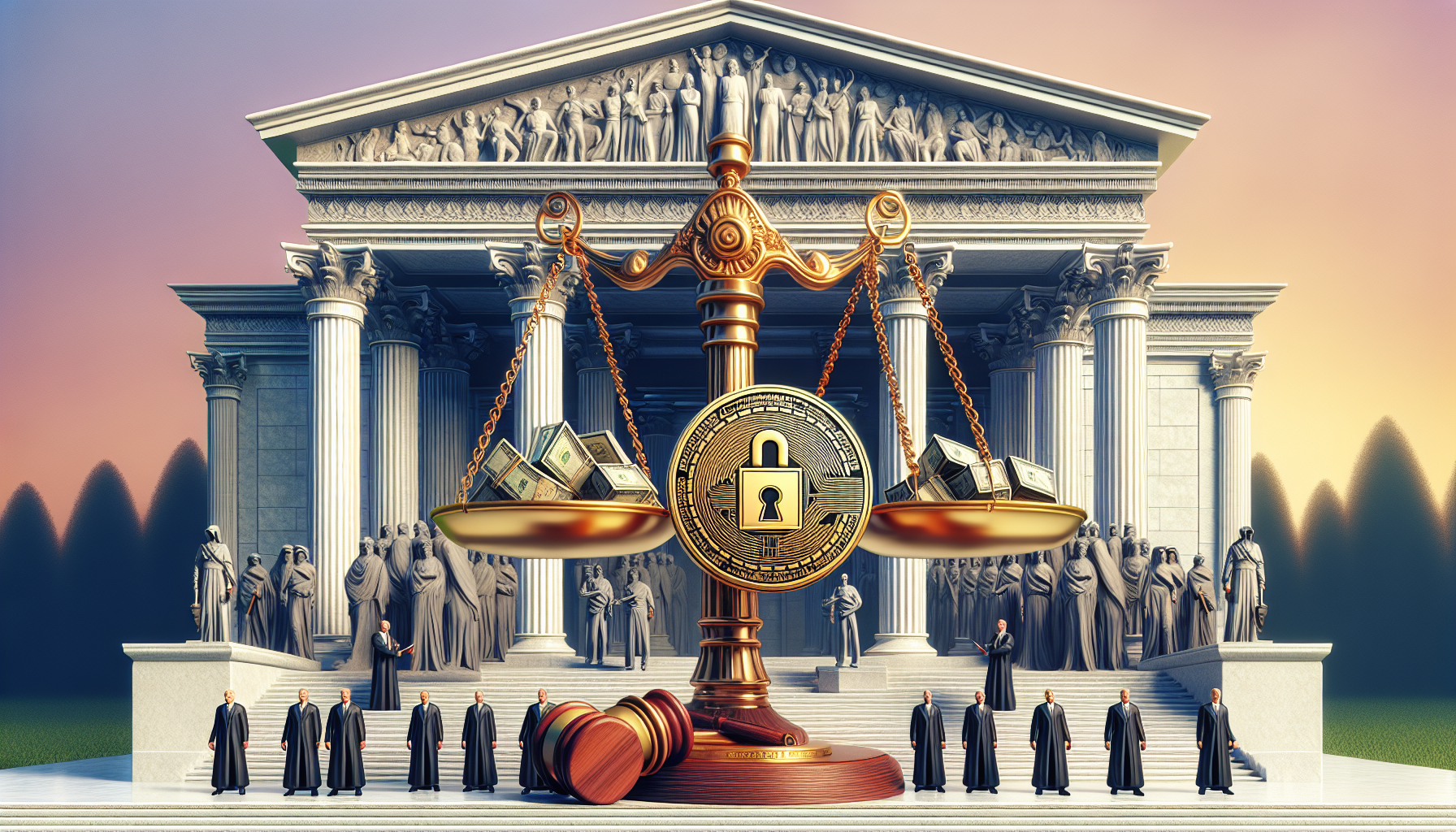Short Answer:
SAFT crypto represents a legal and strategic framework for crypto fundraising, balancing investment opportunities with securities regulations. It offers a compliant path for crypto ventures to secure funding, ensuring investor protection and adherence to federal securities laws.
Introduction & Background
Navigating the dynamic intersection of cryptocurrency and legal compliance, my work has profoundly engaged with the concept of Simple Agreements for Future Tokens (SAFTs), a cornerstone of innovative financial strategies in the crypto realm. With a decade of experience in legal practice, including significant tenure at prestigious AM Law 200 firms and a teaching role in Entrepreneurial Law at the University of Florida, I’ve delved into the complexities of venture capital, mergers & acquisitions, and private equity transactions within the digital asset space. This rich background has equipped me with the nuanced understanding necessary to interpret and contribute to the evolving legal frameworks surrounding cryptocurrency.
My authority on SAFTs is not only grounded in my legal expertise but also in my active participation in shaping the future of cryptocurrency regulation. Collaborating with leading projects and organizations, such as the Uniswap Foundation and Shardeum, has provided me with unique insights into the challenges and opportunities of crypto fundraising. The SAFT model represents a beacon of compliance and security in an industry fraught with regulatory uncertainties. Through my work, I strive to bridge the gap between legal theory and practical application, ensuring that investors and developers alike can navigate the burgeoning world of cryptocurrency with confidence and legal assurance.
Key Takeaways
-
A SAFT (Simple Agreement for Future Tokens) is a legal and financial instrument that balances cryptocurrency fundraising with securities regulations, enabling a safe and compliant investment environment for accredited investors.
-
Investing in SAFTs comes with both high risks and rewards, requiring thorough negotiation of terms such as valuation caps and discounts, and a clear understanding of the venture’s designated triggering events for token distribution.
-
SAFTs must comply with federal securities regulations, necessitating strategic legal steps such as filing with the SEC; they are also geared towards a more sophisticated investor pool who meet certain criteria for accreditation.
Demystifying SAFT Crypto

A SAFT, at its essence, represents a beacon of innovation within the financial landscape, providing a structured path for crypto ventures to acquire funding. These saft agreements are pivotal in harmonizing the dynamic world of cryptocurrency with the rigor of securities regulations, ensuring that both developers and saft investors can navigate this space with confidence.
A SAFT contract serves as more than a mere document; it constitutes a fundamental platform paving the way for a future teeming with digital tokens, all ensconced within the safe harbor of legal compliance.
What is SAFT?
A Simple Agreement for Future Tokens (SAFT) stands as a binding promise, a written contract between the visionaries of cryptocurrency ventures and their financial backers. Unlike a future token warrant, a SAFT is not about mights or maybes – it’s a commitment.
Investors pour capital into the crypto project through an initial coin offering as a cash investment in exchange for the future delivery of tokens, a tangible product of successful milestones achieved by the venture.
Why are SAFTs important?
SAFTs have surfaced as a critical element to ensure legal compliance in the realm of crypto fundraising. They deftly sidestep the risks associated with direct securities classification, a predicament commonly faced by Initial Coin Offerings (ICOs).
By earmarking tokens for future distribution and focusing on accredited investors, SAFTs embrace federal securities regulations, laying a solid foundation for secure and compliant investments.
The SAFT Investment Process

Initiating the SAFT investment journey entails more than merely signing a contract. It’s a careful dance of legal agreements, milestone achievements, and the eventual transfer of tokens. The investor’s journey is marked by a series of carefully negotiated terms, overseen by the watchful eyes of legal experts, ensuring the saft framework aligns perfectly with both the investor’s aspirations and the project’s trajectory.
How to invest in a SAFT
Delving into a SAFT isn’t a trivial undertaking; it’s an arena designated for the select group of accredited investors. Those who meet the stringent financial thresholds set forth by regulatory authorities. This exclusivity is not without reason; it ensures that the participants are well-versed in the intricacies of such high-stakes investments.
As an investor, one must negotiate valuation caps – a critical aspect that weighs company performance, market conditions, and the founders’ track record.
Understanding the risks and rewards
Yet, substantial potential is often accompanied by significant risk. A SAFT investment is akin to navigating a treacherous sea; the threat of project failure looms large, and technical glitches or cybersecurity breaches can obliterate the promised land of token ownership. Yet, for those willing to brave these waters, the rewards can be bountiful – early access to tokens at a fraction of their future price and the chance to be part of groundbreaking projects.
Key Components of a SAFT Agreement

A SAFT agreement is a carefully constructed document, interwoven with legal stipulations that outline:
-
Triggering events
-
Valuation caps
-
Discounts
-
Other terms
Each clause is a pact between the crypto venture and the SAFT investor, ensuring clarity and fairness in their contractual agreement. Legal expertise is not just recommended but essential in drafting these agreements, as they stand at the intersection of securities and contract law.
Triggering Events
Triggering events are the milestones that every SAFT investor eagerly anticipates. They are the harbingers of token distribution, marking the moment when the digital promises crystallize into tangible assets. Be it the launch of a product or a liquidity event, these triggers are carefully negotiated to reflect not just the startup’s progress but the investor’s expectations for the venture.
They symbolize investor protection, ensuring that tokens or future equity are disbursed only when the startup has reached a state of maturity, taking into consideration the maximum token value.
Valuation Caps and Discounts
Valuation caps and discounts are the shields that guard early investors from the dilution of their stakes, especially when a company reaches its initial public offering. They set a ceiling on the company’s valuation for token or equity conversion, ensuring that the early risk-takers are rewarded proportionately as the venture’s value soars.
Discounts sweeten the deal, allowing investors to purchase tokens at a rate lower than future financiers, a token of gratitude for their foundational support and an opportunity to receive future tokens.
Regulatory Aspects of SAFT Crypto

The task of navigating SAFTs’ regulatory waters is laden with complexities. Designed to align with securities laws, these agreements must satisfy the stringent criteria set by federal securities regulations. The SEC’s Howey Test scrutinizes SAFTs as investment contracts, placing them under the watchful gaze of federal laws and securities regulations.
This regulatory maze, albeit challenging, is a cornerstone of the SAFT’s credibility and investor confidence.
Accredited Investors and their Role in SAFTs
Accredited investors, characterized by their significant financial acumen, form the lifeblood of the SAFT ecosystem. As an accredited investor, the stringent criteria of income and net worth not only filter the investor pool but also ensure that those who partake in SAFT investments are well-equipped to understand and navigate the complexities involved.
Their exclusive participation in company representations is a safeguard, ensuring that these sophisticated investment vehicles are handled with the finesse they demand, ultimately providing financial security.
Compliance with Federal Securities Regulations
Compliance forms the cornerstone of SAFTs. The intricate dance with federal securities regulations requires issuers to make strategic moves, like filing a Form D with the SEC under Regulation D, ensuring that every step taken is within the bounds of legality as per the Securities Exchange Act. It’s a protective measure, one that fortifies investor trust and safeguards the integrity of the SAFT investment process.
With the crypto industry poised on the brink of increased regulation, investors and issuers must remain vigilant, ready to adapt to an evolving legal landscape.
Comparing SAFT to Other Investment Vehicles

Among a plethora of investment opportunities, SAFTs distinguish themselves with their singular approach to fundraising. They diverge from the paths tread by ICOs and SAFEs, charting a course that is distinctly their own. By understanding these distinctions, investors can make informed decisions, choosing the vessel that best suits their voyage toward financial growth.
SAFT vs. ICO
The distinction between a SAFT and an ICO is stark. SAFTs, with their promise of future tokens, offer a glimpse into a future where the project’s success is a shared journey with the investor. ICOs, on the other hand, deliver immediate tokens, a transaction rooted firmly in the present. This timing difference is just one aspect of the broader regulatory divide that separates the two, with SAFTs falling squarely within the SEC’s purview.
SAFT vs. SAFE
While both SAFT and SAFE agreements share a common thread of non-debt financial instruments, their focus diverges at the crossroads of crypto and traditional startups. A SAFT hinges on the future of tokens, a digital asset tied to the blockchain, while a SAFE leans toward potential equity, a stake in a company’s future. Each carries its own set of risks and potential rewards, tailored to the investor’s appetite for innovation and their vision for the future.
Navigating the Future of SAFT Crypto
The boundaries of SAFT crypto continually expand, adapting to the interplay between regulatory scrutiny and the inventive spirit of the crypto industry. As issuers and investors chart their course through these waters, they must remain agile, ready to embrace new token distribution models and the evolving expectations of a more sophisticated investor base.
Emerging Trends in SAFT Crypto
The SEC, also known as the Securities and Exchange Commission, maintains a fluid stance that drives emerging trends in the SAFT landscape, providing a beacon of regulatory clarity. Amendments that provide safe harbors against integration signify a more navigable course for crypto entrepreneurs. By leveraging these new rules, they can strategically position their offerings for smoother sailing within the confines of federal securities laws, avoiding the tumultuous waters once navigated by unfortunate predecessors.
Challenges and Opportunities for SAFT Investors
The road ahead for SAFT investors is characterized by a mix of challenges and opportunities. Here are some key points to consider:
-
Market consolidation and institutional interest could bring stability and credibility to the market, paving the way for participation in innovative blockchain ventures.
-
Early-stage investors, shielded by valuation caps, can seek significant returns in this dynamic environment.
-
However, it is important to navigate the risks associated with digital asset investments.
Summary
As we conclude this journey through the intricate world of SAFT Crypto, it’s evident that these agreements represent a harmonious blend of traditional investment principles and the pioneering spirit of the cryptocurrency industry. SAFTs offer a structured and legally compliant avenue for raising capital and investing in the future of digital assets. They stand as a testament to the industry’s ability to innovate while respecting the boundaries of regulation, ensuring investor protection and project viability.
Frequently Asked Questions
What is a Saft contract?
A Saft contract, or a simple agreement for future equity (SAFE), is an agreement between an investor and a company that provides rights to the investor for future equity in the company without determining a specific price per share at the time of the initial investment. It is also used in the domain of cryptocurrencies between developers and authorized investors.
Is SAFT a derivative?
Yes, the SAFT (Simple Agreement for Future Tokens) is considered a derivative of the SAFE (Simple Agreement for Future Equity). This agreement provides rights to the investor for future equity in the company without determining a specific price per share at the time of the initial investment.
What does the acronym SAFT stand for?
The acronym SAFT stands for Simple Agreement for Future tokens, and it is a security instrument used in cryptocurrency fundraising to eventually transfer digital tokens to early investors without violating regulations.
Is SAFT legally binding?
Yes, a SAFT is intended to be a legally binding investment contract, but its legal status has not been definitively established in court. It is important to be aware of this when considering a SAFT.
Who can invest in a SAFT?
Only accredited investors, who meet certain financial criteria, are legally permitted to invest in SAFTs to ensure a level of financial sophistication and regulatory compliance.



